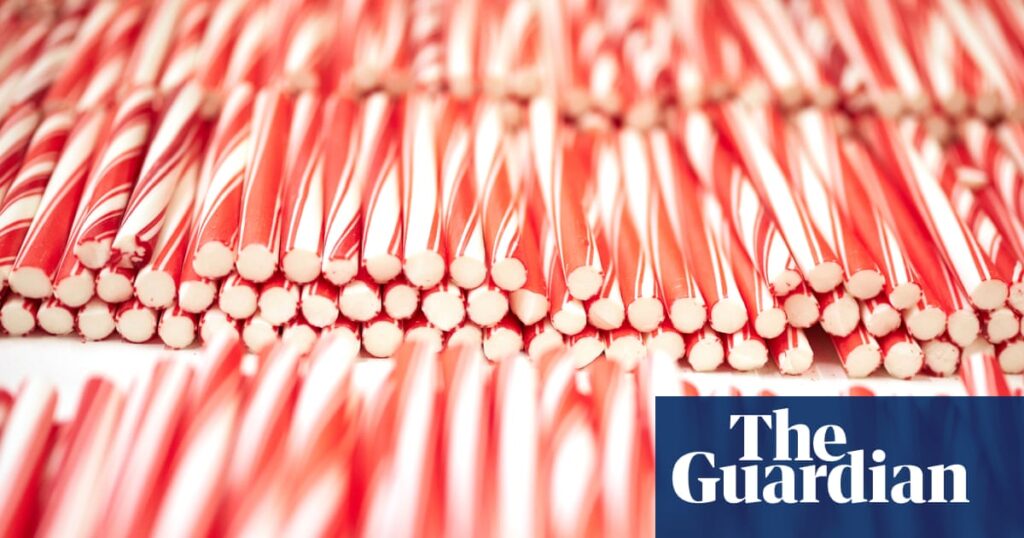Blackpool rock maker leads crusade to protect British seaside staple | Food & drink industry

Today, Parma Violet, bubblegum and salted caramel flavours are being made. On other days, it could be banoffee pie, hot chilli, the nuclear-strength super sour or, for an afterwork treat, Jägerbomb-flavoured rock.
At a small factory making Blackpool rock, the flavours might be different from previous generations but the techniques and skills are the same as they were 60 years ago.
Stepping inside the Stanton & Novelty factory in Blackpool is like entering a time capsule. The smell of burnt sugar is intense. Big splodges of colourful hot toffee are like abstract artworks. Workers handroll 30ft-long snakes of the almost finished rock, which are cut into sticks and wrapped by people, not a machine.
One of the newest things in the factory is the boss, 34-year-old David Thorp, who was working in recruitment in London when, seven years ago, he had to decide whether to take on the family business, set up by his grandfather in 1969.
He did and has managed to get through Covid, rampant energy bills and increasing material costs but now faces, he said, the biggest threat of all: cheap imitation imports from China.
This week, Thorp coordinated a letter to parliamentarians signed by all 10 manufacturers in the town, a rare show of unity for businesses that are fierce competitors.
They are embarking on a campaign for Blackpool rock to be given geographical protection, the same as Stilton cheese and Melton Mowbray pork pies have.
Rock has been a seaside staple for more than a century but most people don’t know that almost all of it is made in Blackpool. It is something of a dying art, said Thorp. Only 30 people in the UK have the knowledge and skills to set the letters that run through it.
Three of them are at Stanton & Novelty and they include Thorp. “It is a really intricate process and might take you five years to know how to do it well,” he said. “You’re dealing with toffee that’s still really hot and unpredictable and constantly sagging because it’s warm. There are 1,001 things that can go wrong.”
So much of the process is done by hand. It begins with sugar, glucose and water being boiled in a copper pot to a precise temperature of 300F (149C).
“If you go a couple of degrees too high, you ruin the boiling,” said Thorp. “A couple of degrees too low and you ruin the boiling.”
The toffee is then coloured and flavoured and thinned by hand. “It’s not something a machine can do. It is all done by experience, you need to know the exact thickness as you’re pulling it … it’s basically like a tug of war for about half-an-hour.”
Setting the letters in the rock is also an involved, fraught process which can easily go wrong. “No machine can put the letters through a stick of rock, it has to be done by hand,” said Thorp. “You’ve got to think of a letter in 3D. As well as being 3D the letter has to be two feet long.”
The process involves folding sheets of coloured workable sugar into the shape of letters that have white sugar in the centre. They are then covered in more white sugar, encased in whatever colours are on the outside and squeezed and rolled into the sticks. “You’ve also got to use white strips to make sure a letter doesn’t blend into the next one,” Thorp said.
after newsletter promotion
The rock is cut and wrapped by hand and it has to be that way, added Thorp. “You wouldn’t get the twisted ends and a machine can’t get the label under the wrapper. It can only add a sticker, which doesn’t look anywhere near as good.”
Blackpool rock’s origins date back to the 19th century and “fair rock”, which was sold at fairgrounds when sugar was cheap and abundant.
According to some, rock with letters through it was the brainchild of an ex-miner from Burnley, Ben Bullock, who then made it in Dewsbury with the first printed words being “Whoa Emma”, the title of a popular music hall song. Others say it was a man called “Dynamite” Dick Taylor, from Morecambe.
Whatever the origins, it is now firmly Blackpool rock, although for how much longer is the pressing question. There were once 30 factories making rock in the town and now there are 10. Next year, Thorp said, there will be eight.
The campaigners are applying to UK geographical protected food names schemes and had been hoping to receive support and advice from local MPs. The problem has been that one was Scott Benton, who was suspended and then resigned, and another is the Fylde MP Mark Menzies, who is quitting following allegations of misusing campaign funds.
It explains the reason for ignored emails, said Thorp. The third local MP is the former defence secretary Ben Wallace, but he is also standing down at the next election.
Those hurdles are not deterring Thorp, who said he didn’t want to wake up one day and ask himself why they didn’t fight harder.
On a normal day, Stanton & Novelty will make about 26 miles of rock and Thorp is determined this will continue.
His proud mum Jan said the passion was typical of her son. “If you chopped David in half, it would say Blackpool rock,” she said.
Source: theguardian.com

